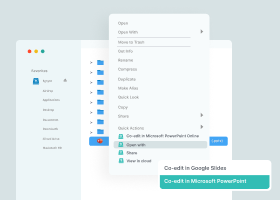Secure and Fast File Transferring
How to Share Large Files
Sharing large files has always been a challenge. Gmail and Yahoo have 25MB limits, and most other email systems also have file restrictions that make sharing large files using email difficult. When sharing large files that exceed these limits, there are several ways to send them over the internet.

Data compression
In some cases, the issue of sharing large files can be solved by simply using a data compression tool to reduce the file size. With data compression, data in the file is re-encoded to use fewer bits of storage than the original file, thereby reducing the file size. Then, this compressed file is sent and restored to its original structure. This process is called data decompression. Data compression can be used to reduce the size of one file, or multiple files can be bundled into a single compressed file. Note that a single file will transfer faster than a folder containing smaller files of the same size.
External drive
An external hard drive enables the transfer of large volumes of data quickly. It is often used to transfer data from an old computer to a new computer or to exchange data with a third party. It is faster than cloud-based systems, which can handle a larger quantity of data, but have slower upload and download times. When using an external hard drive for sharing large files, it is recommended to use a Thunderbolt or USB-C connector rather than a USB Type-A, because of the significantly increased data transfer speed.
File-transfer sites
A third-party file transfer website can be used to upload the files that need to be shared. Sharing large files using a file-transfer site can be as simple as entering the sender’s and recipient’s names and emails and then uploading the file. The site will send the recipient a link to download the file and a confirmation to the sender. The size limitations for sharing large files through a file-transfer site usually depend on the service level that the user has signed up for.
P2P
P2P, or peer-to-peer, is one of the most commonly used and reliable methods for sharing large files. P2P is a process or transaction that happens directly between two peers, usually computer systems, without requiring an administrator to orchestrate and manage it. While it is now used for a variety of use cases, P2P was initially purpose-built to support sharing large files between systems. P2P can use used to share any type of digital media between any kind of connected device.
Store files online
When files are uploaded to a cloud storage site, links can be shared to make downloads accessible. Most services offer free cloud storage space that can also be used as a platform for sharing large files. Some services offer up to 15GB of free space. Others only offer up to 5GB. When users exceed the free upload limits, they have to upgrade to a paid plan to continue to use the cloud-sharing platform to share large files.
Virtual private networks
A virtual private network, also called a VPN, can be used for sharing large files. While it comes as a surprise to many people, a virtual private network is a great tool for sharing large files between users. It is a bit of a hack that gets around broadband traffic controls used by some internet service providers (ISP) to moderate upload bandwidth. If a virtual private network is used, the ISP cannot see the files being uploaded, so they cannot stop users from uploading large files for sharing.
Other Ways to Increase Speed when Sharing Large Files
Cable broadband
If available, plug a computer into a modem using a cable to transfer the file. Then, if possible, plug into an Ethernet port on the computer to get a 1Gbps connection to the modem (assuming it uses 1Gbps ports). This improves reliability and mitigates the risk of interference from other appliances. It also supports a high transfer rate, which ensures that users do not hit speed ceilings.
Faster internet access
To help expedite sharing of large files, find a service provider that prioritizes upload speed. Faster service is usually available from service providers that offer FTTP (or Fiber to the Premises), which is essentially having an optical cable physically plugged into the property. Business broadband also usually provides a lower contention ratio.
Use Bonding to combine internet connections
Bonding combines two internet connections to make a faster one, such as satellite/Wi-Fi and satellite/Wi-Fi for desktop systems, 3G/4G/5G cellular networks for desktop systems or mobile devices.
Use the 802.11ax wireless protocol
The latest 802.11ax wireless protocol can significantly reduce transfer times when uploading and sharing large files. Note that this will require compatible devices both on the client and transmitting sides (e.g., the router).
What to Look for in a File Sharing Service
The most important feature to look for in a file sharing service is the size limitation when sharing large files. Beyond this, there are a number of other considerations.
Benefits to Look for When Evaluating Systems for Sharing Large Files
Below is a summary of benefits to look for in a file sharing service or tool that can be used when sharing large files.
Cloud storage services
- Allows users to create links to files
- Automates synchronization
- Available as a scalable subscription-based platform
- Can be used as the corporate file server
- Enables secure file distribution
- Has a tool to compress large files
- Includes user management, permissions, and access controls at user and file levels
- Integrates with other cloud-based storage options (e.g., Dropbox, Google Drive, OneDrive)
- Offers the option to add special rules to links, such as expiration dates or click tracking
- Provides a scalable solution that works well for both small and large organizations
- Supports collaboration and sharing large files
- Syncs local files for backup and cross-device availability
- Transfers files from any connected device
Data compression
- Provides more control over which channel you send the files
- Reduces time to transfer files
- Saves money by reducing cloud-based storage expenses related to the amount of data stored
Use a VPN
- Allows for private and secure data transfer between two sites
- Circumvents protocol or application-based throttling
- Can be faster than using a public service
FTP
- Accessible to all users, even those who are not tech-savvy
- Does not have restrictions on file type, size, or number of transfers
- Makes it easy to trade files with known and trusted third parties
FTPS
- Uses encryption to protect data sending large files
- Meets security requirements to maintain compliance with most regulatory frameworks (e.g., PCI DSS, SOX, HIPAA)
SFTP
- Includes more secure options than FTP to better protect data in transit
- Does not utilize a large number of open ports
- Can move files using CLI
Red Flags to Look for When Evaluating Systems for Sharing Large Files
Below are some red flags to keep an eye out for when looking for a system for sharing large files.
Cloud storage services
- Difficult for users who are not very technical
- Does not offer a free version
- Hard to separate personal and work files
- Not easy to switch between accounts
- Challenging to implement permission management at scale
Data compression
- A manual process that requires knowledge of data compression techniques
- No way to automatically apply compression to files
- Ineffective for files that are already in compressed formats
- Complex for the recipient to decompress and retrieve files
VPN
- Users must have a technical understanding of how to set up a site-to-site VPN or how to install one on their own
- One-off transfers are not viable
- Set up is suited for long term file-trading, such as EDI arrangements
FTP
- Security is weak
- Easily hackable if misconfigured or has weak credentials
- System will not work if either site is having server or internet issues
- Technical setup requires IT experience
FTPS
- A port is opened whenever a file transfer is made a
- Difficult to use FTPS connections
- Lack of support for FTPS
SFTP
- Security is weak
- Easily hackable if misconfigured or has weak credentials
- System will not work if either site is having server or internet issues
- Technical setup requires IT experience
How to Send Large Files Via Email
As many organizations’ primary communications channel, email is the obvious go-to when a user wants to share a file to someone. It works well for most files but falls down when it comes to sharing large files. For example:
- Gmail attachment size limit is 25 MB
- Outlook/Hotmail attachment size limit is 33 MB, but it gives a warning that the file is too large when it exceeds 25 MB
- Yahoo attachment size limit is 25 MB
- Outlook client attachment size limit is set by the email provider
- iCloud Mail attachment size limit is 20 MB
- Facebook Messenger attachment size limit is 25 MB
- Skype attachment size limit is 300 MB
- WhatsApp attachment size limit is 16 MB
A common workaround to sharing large files via email is using data compression to make attachments smaller. Also referred to as “zipping,” data compression uses algorithms to reduce the amount of space needed to represent a file. Data compression can be done in two ways:
1. Lossless compression—the algorithm reduces the size of a file without losing any information in the file so that the original data can be reconstructed from the compressed file.
2. Lossy compression—the algorithm reduces the size of a file by discarding the less important information in a file, which minimizes the file size but also impacts the quality of the data in the file.
Alternatively, other technologies can be used for sharing large files via email, including:
- Cloud storage services
- VPN
- FTP
- FTPS
- SFTP
Efficient File Sharing Collaboration
Organizations have expanded the practice of virtual collaboration. With this, individuals and teams work together across geographies with information that is shared online. In many cases, these collaborative workspaces have become the primary hub for employee communication.
Making file sharing collaboration more efficient increases overall productivity and satisfaction. This collaboration inevitably includes sharing large files. This capability is critical to efficient file sharing collaboration. When done well, file sharing collaboration yields meaningful and powerful benefits.
What are the Advantages of Online File Sharing?
While there are many benefits of efficient file sharing collaboration, the following are several that are most commonly cited.
- Offering the ability to share large files helps organizations make it easy and secure, because people can share and access files from anywhere, anytime, with their phone, computer, or tablet.
- Desktop and mobile applications enable file syncing and sharing.
- Robust tools allow administrators to monitor behavior and control access to optimize security.
- All team members can have access to a critical document and make changes to it simultaneously by logging into the file-sharing system at the same time to perform their respective tasks.
- File sharing ensures that all team members have updated versions of the same document, and when changes are made to a file, everyone with access is able to see those changes.
- Many of the risks for miscommunication are eliminated by providing ready access to the most current version of documents.
- Users can continue working on a project even when a valuable team member quits or is unexpectedly unavailable.
- Collaborating by secure file sharing helps organizations cut down on various administrative costs.
- The ability to send and receive files immediately, then view a document and share comments in real time helps teams meet tight deadlines and deliver quick turnarounds.
- File sharing collaboration also helps keep files and comments in one organized area, eliminating the need to sort through endless email chains and folders.
Leverage Technology for Easily Sharing Large Files
Traditional approaches for sharing large files are mostly obsolete. Instead, organizations must use technology for sharing large files. With the right tools in place, security will be enhanced, and productivity will increase.
As discussed above, many technologies can be used to facilitate large file sharing. In most cases, sharing large files can be done using networks and the internet. From point products focused on the simple act of transferring files to sophisticated solutions that provide storage and collaboration capabilities, sharing large files can be done securely and efficiently.
However, while systems for sharing large files provide many benefits, there are always risks. Remain cautious and follow best practices to avoid security issues, such as not clicking links or opening files that come from unknown sources.
Egnyte has experts ready to answer your questions. For more than a decade, Egnyte has helped more than 16,000 customers with millions of customers worldwide.
Last Updated: 3rd April, 2023



